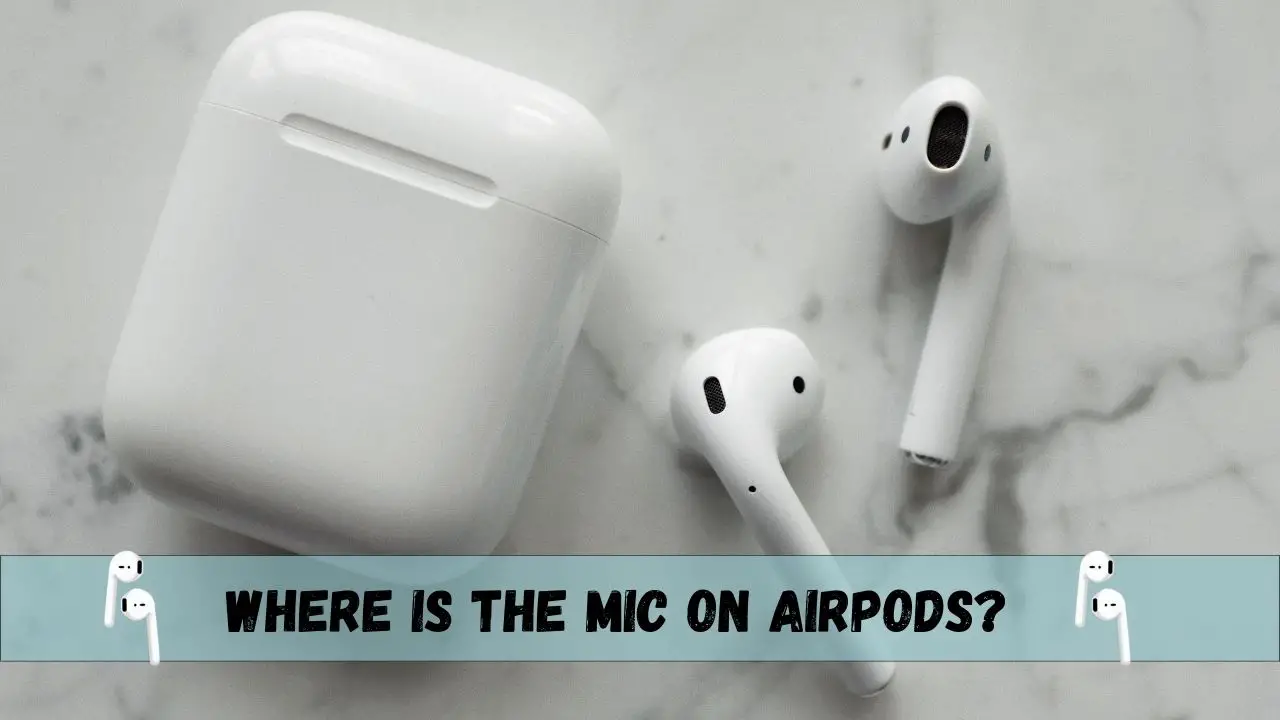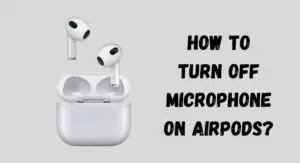Apple is a brand name, and while looking for wireless headphones, many Apple users opt for Airpods. They offer great sound quality and an amazing look. If you are one of those who own AirPods, you might wonder, ‘where is the mic on AirPods pro or AirPods’ this article will answer all your microphone-related queries.
Why Are The Airpods Microphones Essential?
Microphones are essential in earphones because a person needs a mic for many things. The microphone is used to translate sound vibrations in the air into electronic signals. Microphones are used for communication and various other purposes.
AirPods are used when we facetime anyone or when we have to record something, Siri also works best with properly working microphones. Microphones ensure that you have a clear and proper conversation with anyone or anything.
Where Is The Microphone On Airpods Located?

Airpods Microphone location is quite conspicuous to the user. In Airpods, mics are located in two areas. One is pretty visible, which is the downside of each AirPod, and the other is inside the earphone, which is not visible to the naked eye. Internal microphones are provided for noise cancellation features and to give users the best experience of calls and sound.
AirPods are set to automatic mode. When using one AirPod, that one AirPod acts as a microphone.
How Many Microphones Does Airpods Have?

At first glance, we can only see one microphone In one AirPod, at the end of the stem. Another microphone is inside the earpiece. So in total, a pair of AirPods have four microphones. The microphone at the end is used mainly for calls or using Siri.
The microphone at the end records your voice as it’s directly near your mouth. The other microphone inside the earpiece helps to cancel the external noise.
Is There A Mic Inside The Airpods?
Yes! We have discussed the Airpods mic location in this article. You would be happy to know that each Airpod has two mics, one visible to everyone and one in-built mic.
The second microphone on AirPods essentially functions as a beam-forming microphone with the sole objective of obstructing any outside sounds or speech and keeping them from reaching your ears. With the secondary microphone, you may listen to your favorite music albums while being less distracted by background noise. The other party will hear the voice picked up by the primary microphone while you are on a phone or video call. Thus, it significantly enhances call quality as well.
Both microphones have a significant role and are essential for the great sound quality of Airpods.
How Do I Test My Airpods Mic?
We have to follow the following steps to test our microphone:
- The AirPods will first be connected to your iPhone or Android device. Before you start, make sure your AirPods are charged.
While your AirPods are inside the charging case, hold it next to your iPhone, open the case, and select Connect. Setting up the AirPods is a little more difficult if you don’t own an iPhone. Open the “Bluetooth Settings” on your Android or other non-Apple devices, then connect your AirPods.
- The “Voice Memos” app on your iPhone or Android should then be used to test the microphone. Find the Voice Memos app on your iPhone, which is typically in the “Extras” folder, and open it.
Find the built-in sound recorder app on an Android smartphone and open it. These devices already have sound recording apps installed, but you can choose to download any other software from the App Store or Play Store and use it if it better matches your needs.
- Now record yourself and hear it afterwards. You must push the “red” record button to start the recording before speaking into the microphone. You can use a loud voice or a whisper to test the microphone’s functionality. You may sense what the microphone can pick up from this.
- The following step in evaluating the microphone is listening to the recording and examining its sound once the voice memo has been recorded. By doing this, you can judge how well the microphone on your AirPods performs. Testing the microphone on your AirPods is as easy as that. If you hear anything unpleasant or your recording levels are excessively loud or too quiet, there might be a problem with the microphone.
Why Isn’t The Mic On My Airpods Working?
If the microphone on your AirPods is not working, you may try the following steps:
- Most audio issues with your AirPods can be fixed by reconnecting to your iPhone, especially if they were working properly just a moment ago. Simply place both earbuds in their charging or smart case, take them out again, and repeat as necessary.
- Your AirPods’ microphone holes may have a lot of dirt inside them if you’ve used them for a while. As a result, the microphone on the AirPods may sound distorted. Try cleaning them. First, lightly mist a cotton swab with rubbing alcohol; don’t let it become saturated.
To remove any dirt, dab the microphone holes on the bottom of the AirPods. Then, carefully remove any dirt using a toothpick or a pair of tweezers. Take special care not to scratch the mesh grill that covers the microphones.
- If you can only use one AirPod microphone, it’s conceivable that your settings are to blame. Check the active microphone setting to determine whether your AirPods are set up to use both mics. Select Bluetooth from the Settings menu, then hit the I icon next to your AirPods.
Then, hit Microphone and turn on Automatically Switch AirPods to allow your AirPods to choose the best microphone for the situation.
- The AirPods mic not working is a common issue if the firmware is outdated. To check the Firmware Version of your AirPods, go to Settings > General > About > AirPods. Try updating the firmware if you notice a version number that is out of date.
To update that, plug your AirPods into a charging station and place them next to your internet-connected iPhone. After 30 minutes, check back again; they should have been updated.
- To fix occasional connectivity issues that prevent your iPhone (or another connected device) from correctly detecting the input audio from your AirPods, you can also try restarting it.
Is the Airpods mic good?
Yes, it’s simply amazing! When you use AirPods, they are made to provide you with a completely hands-free experience. Having said that, no one on the call will ever complain about your voice being muddled or less audible if you ask them about the sound quality they are hearing from your end. They are that good.
Additionally, the fact that AirPods always activate Siri when you ask for it shows that the microphone can pick up your voice very clearly.
Do AirPods have Active Noise Cancellation?
You won’t find the Active Noise Cancellation feature on the first-generation or second-generation AirPods. Apple only let the AirPods Pro use the Active Noise feature. An extra microphone that faces your ears is present in AirPods Pro.
Therefore, if it notices any environmental noises, it fully mutes them. Having said that, speaking will be difficult when the Active Noise Cancellation feature on the AirPods Pro is used. Everyone who uses the active noise cancellation feature for the first time finds it a genuinely unexpected experience because it nearly totally isolates you from the outside world.
The best time to use ANC is during a phone conversation since you can only hear what the person on the other end of the line is saying. The call quality is much better for you because no other noises distract you.
Conclusion
AirPods is a wise choice for anyone who needs the best quality earphones. They offer good microphone quality with an active noise-cancellation feature. And to provide the best experience, Airpods have four mics, two at the end of the bud and two inside the AirPods.




